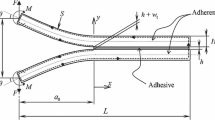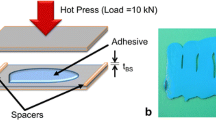Abstract
Adhesive bonding enables joining together thin and dissimilar materials with a negligible increase in weight, which are attractive features in the automotive and aerospace industries. One of the potential sources of failure in adhesive joints is the fatigue damage in the adhesive layer, which often has a complex heterogeneous microstructure. Characterizing the fatigue life of structural adhesives would be a challenging task via numerical techniques. Besides difficulties associated with modeling the adhesive complex heterostructure, the lack of proper micromechanical models to simulate the fatigue damage in this materials system constitutes the major challenge. In this work, we introduce two new high-cycle fatigue damage models, one for the matrix and the other for the particle-matrix interfaces, to predict the fatigue life of a structural adhesive used for automotive applications. High-fidelity finite element (FE) models of representative volume elements (RVEs) of this adhesive are generated using an automated computational framework, enabling the virtual reconstruction of the microstructure and mesh generation. These 3D FE models are used to calibrate the fatigue damage model parameters with fatigue test data under different loading conditions. The calibrated models are then employed to study the impact of micro-voids and particle-matrix interfacial bonding strength on the fatigue life of the adhesive.



























Similar content being viewed by others
References
Alfano M, Furgiuele F, Leonardi A, Maletta C, Paulino GH (2007) Cohesive zone modeling of mode i fracture in adhesive bonded joints. In: Key engineering materials, vol 348, pp 13–16. Trans Tech Publ
Pethrick RA (2015) Design and ageing of adhesives for structural adhesive bonding-a review. Proc Inst Mech Eng Part L J Mater Des Appl 229(5):349–379
Imanaka M, Takeuchi Y, Nakamura Y, Nishimura A, Iida T (2001) Fracture toughness of spherical silica-filled epoxy adhesives. Int J Adhes Adhes 21(5):389–396
Meguid SA, Sun Y (2004) On the tensile and shear strength of nano-reinforced composite interfaces. Mater Des 25(4):289–296
Hongyi X, Li Y, Brinson C, Chen W (2014) A descriptor-based design methodology for developing heterogeneous microstructural materials system. J Mech Des 136(5):051007
Hongyi X, Dikin DA, Burkhart C, Chen W (2014) Descriptor-based methodology for statistical characterization and 3d reconstruction of microstructural materials. Comput Mater Sci 85:206–216
Jiang Z, Chen W, Burkhart C (2013) Efficient 3d porous microstructure reconstruction via gaussian random field and hybrid optimization. J Microsc 252(2):135–148
Fullwood DT, Niezgoda SR, Kalidindi SR (2008) Microstructure reconstructions from 2-point statistics using phase-recovery algorithms. Acta Mater 56(5):942–948
Kumar NC, Matouš K, Geubelle PH (2008) Reconstruction of periodic unit cells of multimodal random particulate composites using genetic algorithms. Comput Mater Sci 42(2):352–367
Yang M, Nagarajan A, Liang B, Soghrati S (2018) New algorithms for virtual reconstruction of heterogeneous microstructures. Comput Methods Appl Mech Eng 338:275–298
Nagarajan A, Soghrati S (2018) Conforming to interface structured adaptive mesh refinement: 3d algorithm and implementation. Comput Mech 62(5):1213–1238
Rahman MM, Ariffin AK, Abdullah S, Noor MM, Bakar RA, Maleque MA (2008) Finite element based fatigue life prediction of cylinder head for two-stroke linear engine using stress-life approach. J Appl Sci 8(19):3316–3327
Fatemi A, Yang L (1998) Cumulative fatigue damage and life prediction theories: a survey of the state of the art for homogeneous materials. Int J Fatigue 20(1):9–34
Ben-Amoz M (1990) A cumulative damage theory for fatigue life prediction. Eng Fract Mech 37(2):341–347
Seyedpoor SM (2012) A two stage method for structural damage detection using a modal strain energy based index and particle swarm optimization. Int J Non-Linear Mech 47(1):1–8
Rao JS, Pathak A, Chawla A (2001) Blade life: a comparison by cumulative damage theories. J Eng Gas Turbines Power 123(4):886–892
Wu W-F, Fu T-T, Yang C-H (2006) Study of fatigue damage accumulation and fatigue reliability based on rotating bending test data. Technical report, SAE Technical Paper
Filippini M, Beretta S, Luca P, Pasquero G, Sabbadini S (2011) Defect tolerance of a gamma titanium aluminide alloy. Procedia Eng 10:3677–3682
Takahashi K, Kogishi Y, Shibuya N, Kumeno F (2020) Effects of laser peening on the fatigue strength and defect tolerance of aluminum alloy. Fatigue Fract Eng Mater Struct 43(4):845–856
Ghidini T, Donne CD (2009) Fatigue life predictions using fracture mechanics methods. Eng Fract Mech 76(1):134–148
Beretta S, Ghidini A, Lombardo F (2005) Fracture mechanics and scale effects in the fatigue of railway axles. Eng Fract Mech 72(2):195–208
Carpinteri A, Spagnoli A (2001) Multiaxial high-cycle fatigue criterion for hard metals. Int J Fatigue 23(2):135–145
Warhadpande A, Jalalahmadi B, Slack T, Sadeghi F (2010) A new finite element fatigue modeling approach for life scatter in tensile steel specimens. Int J Fatigue 32(4):685–697
Naderi M, Maligno AR (2012) Fatigue life prediction of carbon/epoxy laminates by stochastic numerical simulation. Compos Struct 94(3):1052–1059
Herman Shen MH, Akanda SR (2016) A modified closed form energy-based framework for fatigue life assessment for aluminum 6061–t6: Strain range approach. Int J Damage Mech 25(5):661–671
Shen X, Xia Z, Ellyin F (2004) Cyclic deformation behavior of an epoxy polymer. Part i: experimental investigation. Polym Eng Sci 44(12):2240–2246
Jahed H, Varvani-Farahani A (2006) Upper and lower fatigue life limits model using energy-based fatigue properties. Int J Fatigue 28(5–6):467–473
Zhu S-P, Huang H-Z, He L-P, Liu Y, Wang Z (2012) A generalized energy-based fatigue-creep damage parameter for life prediction of turbine disk alloys. Eng Fract Mech 90:89–100
Van Paepegem W, Degrieck J, De Baets P (2001) Finite element approach for modelling fatigue damage in fibre-reinforced composite materials. Compos B Eng 32(7):575–588
Llobet J, Maimi P, Turon A, Bak BLV, Lindgaard E, Essa Y, de la Escalera FM (2018) Progressive damage modelling of notched carbon/epoxy laminates under tensile fatigue loadings. In: 18th European conference on composite materials. European Conference on Composite Materials, ECCM
Dattoma V, Giancane S, Nobile R, Panella FW (2006) Fatigue life prediction under variable loading based on a new non-linear continuum damage mechanics model. Int J Fatigue 28(2):89–95
Do VNV, Lee C-H, Chang K-H (2015) High cycle fatigue analysis in presence of residual stresses by using a continuum damage mechanics model. Int J Fatigue 70:51–62
Ping H, Meng Q, Weiping H, Shen F, Zhan Z, Sun L (2016) A continuum damage mechanics approach coupled with an improved pit evolution model for the corrosion fatigue of aluminum alloy. Corros Sci 113:78–90
Bomidi JAR, Weinzapfel N, Wang C-P, Sadeghi F (2012) Experimental and numerical investigation of fatigue of thin tensile specimen. Int J Fatigue 44:116–130
Graner Solana A, Crocombe AD, Ashcroft IA (2010) Fatigue life and backface strain predictions in adhesively bonded joints. Int J Adhes Adhes 30(1):36–42
Shenoy V, Ashcroft IA, Critchlow GW, Crocombe AD (2010) Unified methodology for the prediction of the fatigue behaviour of adhesively bonded joints. Int J Fatigue 32(8):1278–1288
Harper PW, Hallett SR (2010) A fatigue degradation law for cohesive interface elements-development and application to composite materials. Int J Fatigue 32(11):1774–1787
Khoramishad H, Crocombe AD, Katnam KB, Ashcroft IA (2010) A generalised damage model for constant amplitude fatigue loading of adhesively bonded joints. Int J Adhes Adhes 30(6):513–521
Katnam KB, Crocombe AD, Khoramishad H, Ashcroft IA (2010) Load ratio effect on the fatigue behaviour of adhesively bonded joints: an enhanced damage model. J Adhes 86(3):257–272
Hill R (1985) On the micro-to-macro transition in constitutive analyses of elastoplastic response at finite strain. In: Mathematical proceedings of the Cambridge philosophical society. Cambridge Univ Press, vol 98, pp 579–590
Lemaitre J (2012) A course on damage mechanics. Springer, Berlin
Mitra N, Raja BR (2012) Improving delamination resistance capacity of sandwich composite columns with initial face/core debond. Compos B Eng 43(3):1604–1612
Khoramishad H, Crocombe AD, Katnam KB, Ashcroft IA (2010) Predicting fatigue damage in adhesively bonded joints using a cohesive zone model. Int J Fatigue 32(7):1146–1158
Deb K, Pratap A, Agarwal S, Meyarivan TAMT (2002) A fast and elitist multiobjective genetic algorithm: Nsga-ii. IEEE Trans Evol Comput 6(2):182–197
Ortiz M, Pandolfi A (1999) Finite-deformation irreversible cohesive elements for three-dimensional crack-propagation analysis. Int J Numer Meth Eng 44(9):1267–1282
Abaqus G (2011) Abaqus 6.11. Dassault Systemes Simulia Corporation, Providence, RI, USA
Prior AM (1994) Applications of implicit and explicit finite element techniques to metal forming. J Mater Process Technol 45(1–4):649–656
Dhanasekar M, Haider W (2008) Explicit finite element analysis of lightly reinforced masonry shear walls. Comput Struct 86(1–2):15–26
Taghipour E, Vemula SS, Wang Z, Zhou Y, Qarib H, Gargesh K, Headings LM, Dapino MJ, Soghrati S (2018) Characterization and computational modeling of electrical wires and wire bundles subject to bending loads. Int J Mech Sci 140:211–227
Duan QY, Gupta VK, Sorooshian S (1993) Shuffled complex evolution approach for effective and efficient global minimization. J Optim Theory Appl 76(3):501–521
Duan Q, Sorooshian S, Gupta VK (1994) Optimal use of the sce-ua global optimization method for calibrating watershed models. J Hydrol 158(3–4):265–284
Singer S, Nelder J (2009) Nelder-Mead algorithm. Scholarpedia 4(7):2928
Acknowledgements
This work was funded by Honda Development & Manufacturing of America, LLC and also in part by an allocation of computing time from the Ohio Supercomputer Center (OSC) and the Ohio State University Simulation Innovation and Modeling Center (SIMCenter). The corresponding author also acknowledges the partial support through Air Force Office of Scientific Research (AFOSR) under Grant Number FA9550-17-1-0350 for the development of microstructure reconstruction and mesh generation algorithms used in this work.
Author information
Authors and Affiliations
Corresponding author
Additional information
Publisher's Note
Springer Nature remains neutral with regard to jurisdictional claims in published maps and institutional affiliations.
Rights and permissions
About this article
Cite this article
Ji, M., Smith, A. & Soghrati, S. A micromechanical finite element model for predicting the fatigue life of heterogenous adhesives. Comput Mech 69, 997–1020 (2022). https://doi.org/10.1007/s00466-021-02126-x
Received:
Accepted:
Published:
Issue Date:
DOI: https://doi.org/10.1007/s00466-021-02126-x




